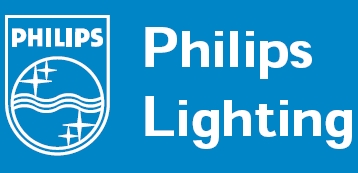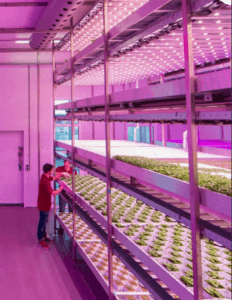Growing a Brighter Future – Philips Lighting

How has agriculture, an industry that thrives outdoors and seems to be diametrically opposed to electronics, come to see a light producer as a partner for growth? Advancements in LED technology have produced lights with a spectrum as powerful as the sun and optimized for growing plants indoors.(1) This has positioned Philips Lighting as a major player in the next generation of agriculture: vertical farming.
In spring 2016, Royal Philips, a major electronics manufacturer, formally divested its lighting division, Philips Lighting, in an effort to capture opportunities in light-emitting diode (LED) space.[2] The newly formed company, with €7.5B in 2015 sales, produces lights for a variety of industries and is squarely focused on finding efficiencies that bring down the energy usage of its light bulbs while improving quality.[3] To support and build these expected technological innovations, Philips Lighting has historically spent 5% of annual sales on R&D efforts.[4] In the process of improving and broadening its lighting solutions, Philips Lighting has started servicing an area that suffers negative consequences from climate change, agriculture, by becoming a producer of vertical farming LED lights.
What is vertical farming?
Vertical farming is broadly defined as growing produce indoors using hydroponics, a soil-less agriculture technique, in an environment controlled settings using LED lighting. The aspect of verticality evolves from the stacking of grow beds which enable indoor agriculture to optimize land use (see Figure 1). Vertical farming allows places previously unable to produce their own food to grow high-quality agriculture products 365 days a year while using 75-90% less water than field agriculture.[5] Enabling communities to grow food locally is an important solution given food scarcity concerns driven by climate and population change. According to the Food and Agriculture Organization, agriculture production must increase 70% by 2050 to feed the world’s population and field agriculture alone will not be enough to cover this surplus.[6] Central to the success and adoption of vertical farming are the advancements in LED technology.
Figure 1:
Lighting the way to agricultural innovations
LED’s are critical to the success of vertical farming because they enable farmers to easily adjust the light spectrum and Photosynthetic Photon Flux Density (“PPFD”). PPFD and light spectrum have been shown to greatly impact the flavor profile, texture, look and even nutrient profile of a vegetable.[7,8] As a result, the LED’s Philips Lighting manufactures has a large impact on the produce that ends up on people’s plates. Additionally, LEDs typically represent the one of the largest capital expenditure for a vertical farm.[9] Understanding this opportunity, Philips Lighting has established a new initiative, City Farming, which focuses on creating intelligent lighting solutions for vertical farming. Today, the City Farming division produces six types of LED lights for agriculture purposes.[10]
To inform its product development, Philips Lighting has built its own vertical farm, GrowWise, in the Netherlands to collect data on plant growth (see Figure 2). Through GrowWise, Philips Lighting has been able to experiment with various lighting ranges and concocted lighting “recipes” that it provides to partner farms to grow produce to certain specifications (eg. increase spiciness of arugula or nutritional content of butterhead lettuce).
Figure 2:
Opportunities
In a space currently occupied by startups and independent farmers, Philips has the opportunity to transform the industry with its global reach and size. Additionally. LED technology is rapidly changing and is arguably the most technical aspect of a vertical farm, because of this, Philips is positioned to be the driving force of innovation in the space.(11) Philips should explore turning its GrowWise R&D facility into a turnkey farming product and sell this solution operators and farmers. Below are two viable partnership opportunities for Philips Lighting to expand its vertical farming expertise.
Drive connection with consumers: One opportunity for Philips Lighting is to partner with grocery stores in Europe and North America to create small vertical farms within stores. At these retail locations, shoppers would see their produce growing, forging a deeper connection with their food and appreciation for its growing environment. As households come to learn about vertical farming, these retail pods would serve as an opportunity for Philips Lighting to drive customer awareness and position Philips Lighting as a thought leader in innovative agriculture solutions. Additionally, this option offers an easily replicable way to offer local produce to consumers.
Offer scale through proprietary or leased farms: A second opportunity lies with municipalities. Now that Philip’s has a vertical farm design, this could be easily replicated in food-scarce geographies. Through establishing partnerships with municipalities, Philips could either sell a farm solution or enter into a long-term revenue sharing contract with city governments to provide fresh produce. This could provide local produce on a larger scale to communities.
Word count (742)
- Philips Lighting, “City Farming,” http://www.usa.lighting.philips.com/products/horticulture/city-farming.html, accessed November 2016.
- Charlie Bray, “Philips to Pursue I.P.O. of Lighting Business in Amsterdam,” New York Times, May 3rd, 2016. http://www.nytimes.com/2016/05/04/business/dealbook/philips-to-pursue-ipo-of-lighting-business-in-amsterdam.html accessed November 2016.
- Philips Lighting, 2016 Prospectus p. 3. http://www.ipo.lighting.philips.com/prospectus, accessed November 2016.
- Philips Lighting, 2016 Prospectus p. 2. http://www.ipo.lighting.philips.com/prospectus, accessed November 2016.
- Vertical Farming Association, “Vertical Farming Infographics,” https://vertical-farming.net/vertical-farming/vertical-farming-infographics/, accessed November 2016.
- United Nations Food and Agricultural Organization, “Agriculture in 2050”, http://www.fao.org/fileadmin/templates/wsfs/docs/Issues_papers/HLEF2050_Global_Agriculture.pdf, accessed November 2016
- Filippos Bantisa, Theoharis Ouzounisb, Kalliopi Radogloua, “Artificial LED lighting enhances growth characteristics and total phenolic content of Ocimum basilicum, but variably affects transplant success,” Scientia Horticulturae, vol 198: 277-283. January 2016. http://www.sciencedirect.com/science/article/pii/S0304423815302892, accessed November 2016
- Philips Lighting, “City Farming,” http://www.usa.lighting.philips.com/products/horticulture/products.html, accessed November 2016.
- Morgan Brennan, “The Vertical Farming The Next Big thing in Food,” CNBC, June 2015. http://www.cnbc.com/2015/06/24/vertical-farming-the-next-big-thing-for-food-and-tech.html, access November 2016.
- Philips Lighting, “Horticulture Products and Downloads,” http://www.usa.lighting.philips.com/products/horticulture/products.html, accessed November 2016.
- Maury Wright, “LED lighting advances in horticultural applications, boosts productivity,” LEDs Magazine, July 2014, http://www.ledsmagazine.com/articles/2014/07/led-lighting-advances-in-horticultural-applications-boosts-productivity.html, accessed November 2016.
Images:
- Philips Lighting, http://jewishbusinessnews.com/2015/11/04/cvc-kkr-and-bain-said-to-mull-6-billion-philips-lighting-bids/, accessed November 2016https://www.localwise.com/articles/120-become-an-intern-at-local-greens-urban-farming-in-the-bay-s-backyard
- “Become an Intern at Local Greens: Urban Farming in the Bay’s Backyard” https://www.localwise.com/articles/120-become-an-intern-at-local-greens-urban-farming-in-the-bay-s-backyard, accessed November 2016
- Philips Lighting City Farming, “Taste the New Green,” http://images.philips.com/is/content/PhilipsConsumer/PDFDownloads/Global/ODLI20150715_001-UPD-en_AA-city_farm_booklet_philips_horticulture_non_spread.pdf, accessed November 2016





I was intrigued to learn about the opportunities Phillips Lighting has in vertical farming.
I think it’s a great opportunity to increase the end consumer’s awareness of the brand through demonstrations as well as a great opportunity to innovate internally. I wonder if this is too niche a market for them to focus on selling GrowWise as product. Given the many opportunities Phillips Lighting and LEDs have in a larger energy efficiency infrastructure market, climate change may offer them many more areas to focus their capital investment.
They may also want to consider selling B2B to other entrants in this niche market, like Grove (https://grovegrown.com/community), and use these customer relationships to establish themselves as the best available technology partner.
Such an interesting perspective! I had no idea how powerful lighting could be in indoor farming, and how much this could revolutionize non-traditional agriculture. A few questions:
1. I’ve seen work debating (on both sides) whether hydroponically grown produce was more or less nutritionally dense than organic produce grown in rich soil. You mentioned that the specific spectrum of light can change qualities of the produce and I wonder whether this could affect or even solve the problems of hydroponic produce?
2. While LED lights are much more efficient than incandescents in home use, I assume that energy expenditure is still a significant input/cost for a large-scale LED operation. Does Philips have plans on ways to source this energy in an ecologically-friendly manner? Are there other concerns related to power use?
Thanks!
Using LEDs to drive vertical farming is a novel approach to addressing the issue of agricultural losses in areas affected by climate change and rising sea levels that render land fallow. I believe that global LED prices are on a downward trajectory with decreasing manufacturing costs and capacity glut. This helps adaptation of the technology but it would be interesting to see the company’s business plan with a focus on the projected financials.